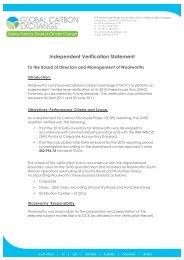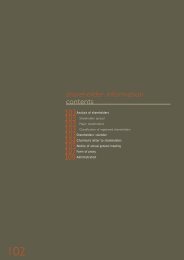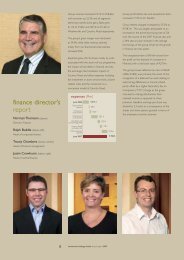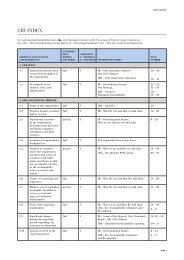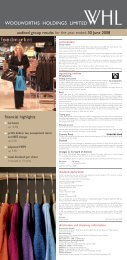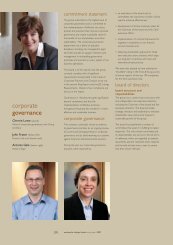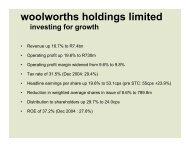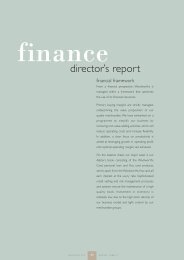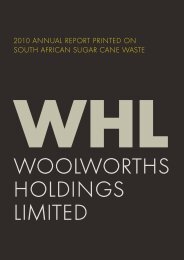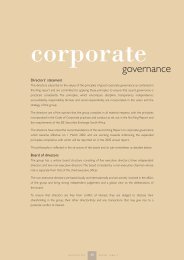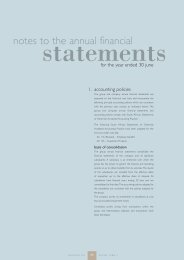WoolWorths holdings limited 2013 good BUsiness JoUrneY report
WoolWorths holdings limited 2013 good BUsiness JoUrneY report
WoolWorths holdings limited 2013 good BUsiness JoUrneY report
Create successful ePaper yourself
Turn your PDF publications into a flip-book with our unique Google optimized e-Paper software.
Environment<br />
WATER<br />
South Africa is a water-scarce country.<br />
In addition, the quality of our water<br />
is increasingly threatened, in part by<br />
industrial and agricultural activity. Growing<br />
public awareness around water has<br />
been driven by droughts, flooding, and<br />
concern about acid mine drainage issues.<br />
The majority of South Africa’s water<br />
resources are used in farming irrigation,<br />
and Woolworths, as a major supplier of<br />
fresh produce, has to play a role in water<br />
conservation. According to WWF-SA the<br />
stress placed on South Africa’s scarce<br />
water resources has resulted in more than<br />
84% of mainstream freshwater ecosystems<br />
being classified as “threatened” in a<br />
national survey.<br />
Woolworths has committed to reducing<br />
water usage and managing waste<br />
water and water effluent across our own<br />
operations, within our supply chain and<br />
through collective action, partnerships,<br />
research and education.<br />
Woolworths is a member of the CEO<br />
Water Mandate – a unique public-private<br />
initiative designed to assist companies<br />
in the development, implementation and<br />
disclosure of water sustainability policies<br />
and practices. We have structured<br />
feedback on progress on Woolworths’<br />
water programme according to the six<br />
focal points of the CEO Water Mandate:<br />
1. DIRECT OPERATIONS<br />
When evaluating new real estate<br />
opportunities, Woolworths considers if<br />
the design of the property enables the<br />
efficient use of water and water waste.<br />
This includes:<br />
• water pulse meters in our facilities to<br />
accurately monitor water usage;<br />
• storage and use of recycled and grey<br />
water systems, retaining as much water<br />
on site as possible for reuse;<br />
• use of indigenous shrubs and ground<br />
covers, minimising irrigation needs; and<br />
• storm-water management – allowing<br />
rainwater to be stored and used.<br />
The installation of pulse meters<br />
has resulted in much better quality<br />
information being available, showing<br />
a 20% decrease in water usage in<br />
stores from our benchmark. Our<br />
improved measurement systems have<br />
allowed us to pick up leaks almost<br />
instantly now, and have challenged<br />
the accuracy of the water bills that<br />
informed our targets.<br />
In 2011 Woolworths Head Office<br />
tapped into an underground water<br />
supply to meet some of its daily water<br />
needs. This water flows into the City<br />
of Cape Town’s storm-water system,<br />
and eventually discharges into the sea<br />
without previously having been used.<br />
Woolworths installed a water treatment<br />
system that purifies the water which is<br />
used to flush toilets, run the building’s<br />
car wash, the fountain outside the<br />
building and the cooling towers for<br />
the air-conditioning units.<br />
Good progress has been made against<br />
the set targets regarding water usage<br />
in head office and distribution centres.<br />
Head office facilities have shown a 35%<br />
decrease in water usage from our 2008<br />
benchmark, with greater savings to come.<br />
Head office consumption for <strong>2013</strong> was<br />
23 463 kilolitres.<br />
We have upgraded our own operational<br />
sustainability objectives and aim to reduce<br />
relative water usage in stores by 50% and<br />
municipal water usage in head office by<br />
70% by 2015.<br />
2. SUPPLY CHAIN<br />
• Farming for the Future measures the<br />
water required for the plant and<br />
irrigation is used only if and when<br />
required. The conservative use of<br />
chemicals also prevents possible<br />
freshwater contamination from<br />
fertilisers and pesticides. Woolworths<br />
is targeting a 30% reduction in water<br />
usage by all Farming for the Future<br />
suppliers by 2015.<br />
• Woolworths certified organic fresh<br />
produce is grown without the use of<br />
artificial chemicals, such as herbicides<br />
and pesticides, and does not release<br />
potentially harmful chemicals into<br />
water supplies.<br />
• We completed a water trial with<br />
66 food suppliers which has highlighted<br />
issues with run-off water (into rivers<br />
and aquifers) from irrigation practices,<br />
and waste water from farm processing<br />
and worked with the United Nations<br />
Global Compact Global Compact<br />
and the German Development Agency<br />
GIZ (GTZ) to further analyse water<br />
usage in agriculture and develop<br />
methods for reduction. A number of our<br />
suppliers improved their waste water<br />
management practices as a result.<br />
• We are working on researching and<br />
understanding the water footprint<br />
of selected priority products. A recent<br />
water footprint analysis of carrots,<br />
beans, cheese, and dishwashing<br />
detergent, completed in conjunction<br />
with Pegasys, has helped us gain<br />
a better understanding of water<br />
dependencies and risks in our<br />
supply chain.<br />
• We are working in partnership with<br />
WWF-SA, WWF-UK, the alliance for<br />
water stewardship, Marks and Spencers,<br />
and ten of our shared fruit suppliers, to<br />
understand the impact of water usage<br />
within our fruit supply chain.<br />
• Within the Clothing unit, Woolworths<br />
has committed to 60% of Woolworths’<br />
clothing products having energy or<br />
water savings by 2015 and will continue<br />
to work closely with suppliers to support<br />
this target.<br />
• All suppliers who make fabric for our<br />
clothes adhere to very strict standards.<br />
No materials, dyes or chemicals used in<br />
the production of Woolworths clothing<br />
or textiles pose what we believe to be<br />
an unacceptable risk to health – or to the<br />
environment – during their manufacture<br />
or disposal.<br />
WHL 74 / <strong>2013</strong> GOOD BUSINESS JOURNEY



